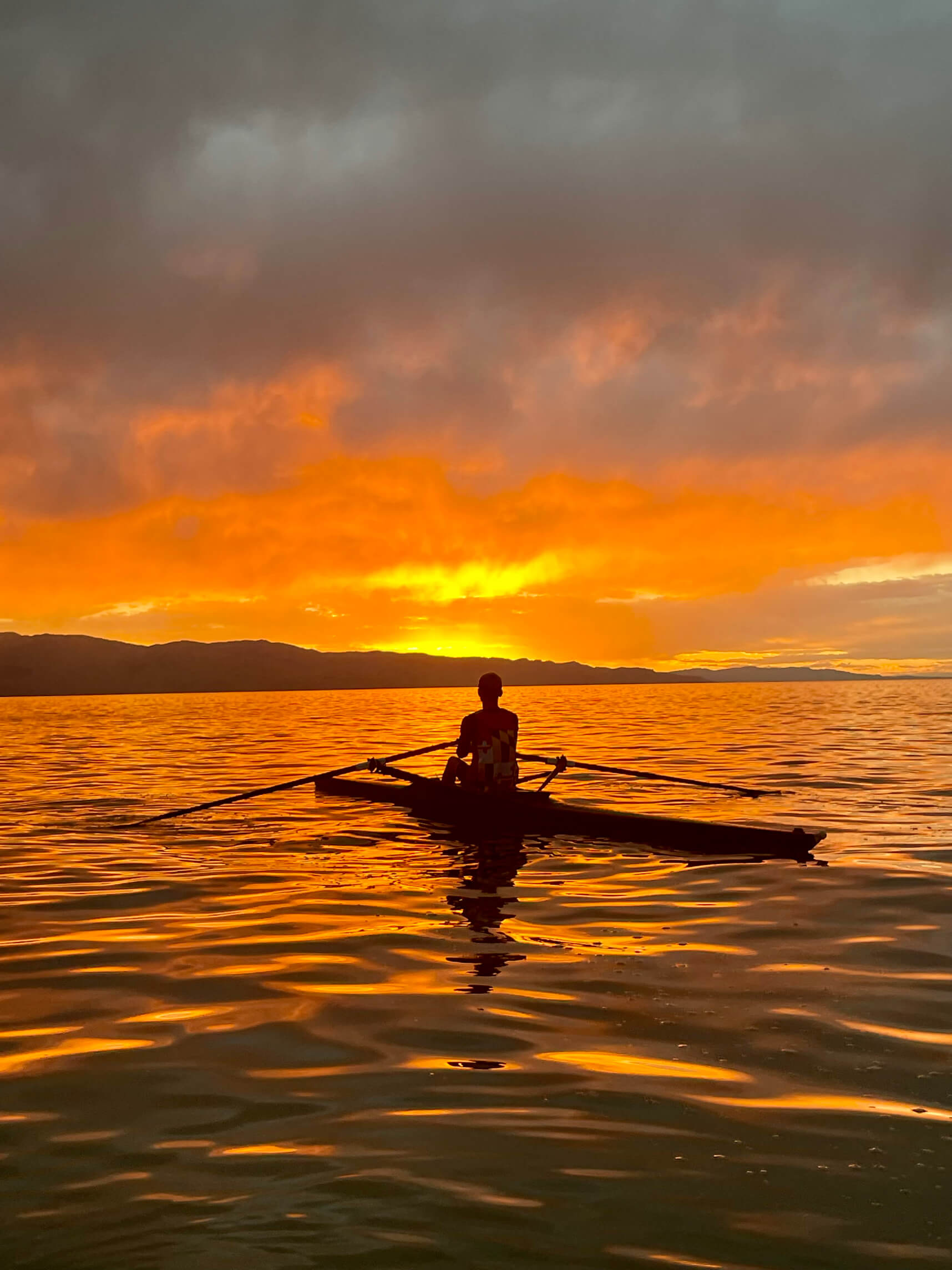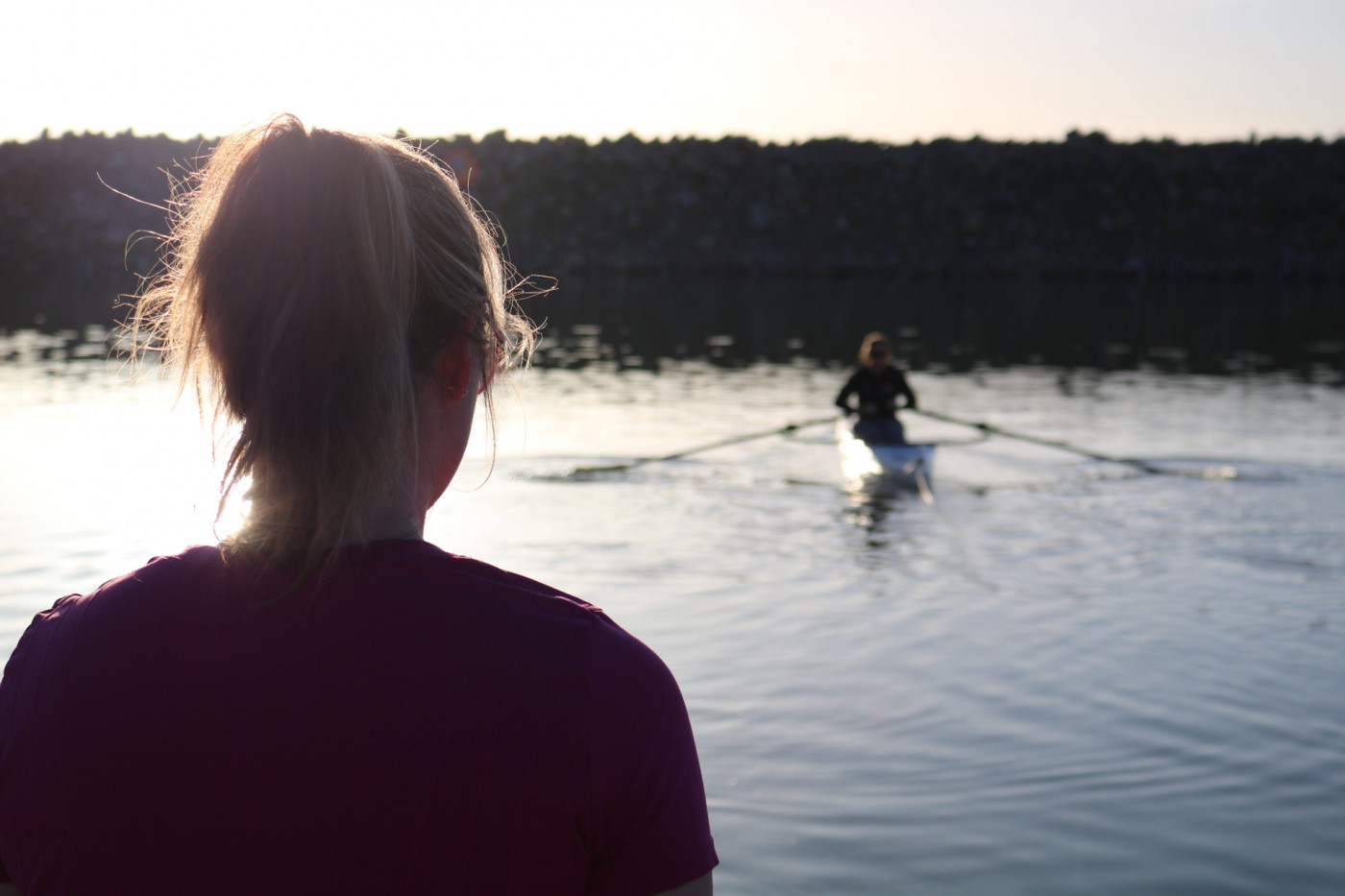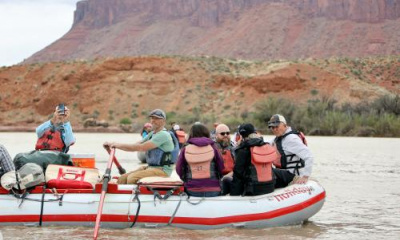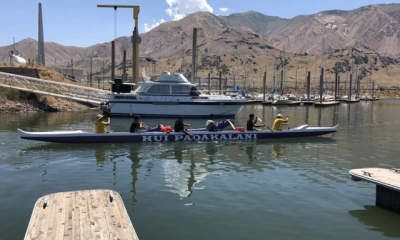Editor's note: This article is part of an occasional series by the Great Salt Lake Collaborative showcasing how to have fun at the Great Salt Lake. For more coverage go to greatsaltlakenews.org.
Rowers practice their strokes as the sun starts its descent in the west over the waters of the Great Salt Lake. A recent April evening is their first time on the water, part of the second lesson of the season for this new group. If they like it, they could be ready to move beyond the stone-walled marina and into the open water by the end of the two-week session of lessons. It's a chance to learn to row and appreciate the lake, which is in the midst of a long decline as its water level drops.
Despite the shrinking lake and the constant concerns surrounding it – environmentally, politically and economically – new people still come to Great Salt Lake to learn to row alongside others who have been on the water for decades. Instructors from Great Salt Lake Rowing, a nonprofit club based at the lake’s marina, promote rowing as a competitive sport and a recreational activity for people of all skill levels.
“I grew up here and always took the lake for granted,” said Sarah Waters, who joined the club in 2022 after taking one of the beginning rowing classes. “It wasn’t until I started rowing that I realized just how beautiful and amazing it is. I wish more people would be able to experience it, and I feel really fortunate that I found rowing and have the opportunity to be out on the water.”
The club, Waters said, leans into a shared passion for rowing. The “Learn to Row” lessons take place throughout the spring and summer to introduce the sport to Utahns living in the lake’s surrounding communities.
Both seasoned members and new rowers said people are drawn to the sport for various reasons, whether it’s to stay active, be a part of a welcoming community, or simply enjoy the beautiful nature of the lake. Reagan Bartholomew, who took the class in April, said she has been rowing on an indoor machine and recently decided to take her exercise to the water.
“I love nature, and I wanted to do actual rowing,” she said.
Learn-to-row lessons are for beginners who want to get out on the water and see what the sport is all about, said the club’s president, Meghan Saunders. Lessons cost $160 for a five-session course and focus on water safety, erging (land training), basic stroke, boat maintenance and how to row in a single boat. The club also offers private lessons and training for experienced rowers.
“I missed being on the water,” said Amber Schiavone, another learn-to-row student who spent considerable time on the waters back in Michigan, her home state.
Rowing on Great Salt Lake, she said, was “cooler” and more interesting than what she was used to back east.
‘Unlike any other place’
While Utah’s ski resorts and national parks tend to garner more attention, Great Salt Lake has been a recreational hub in Utah for more than 150 years and is visited by swimmers, boaters, bikers, hikers and hunters. The lake is also home to the Great Salt Lake Rowing Club, which for over 20 years, has offered community to a group of rowers who hit the water up to three times a week from late spring to early fall and train for national competitions.
“[It’s] a community of incredible, supportive people,” said Kay Denton, who has spent the last 32 years rowing on the lake. “I’ve watched the board grow and enrich the club over the last 20 years.”

Crew from Great Salt Lake Rowing in an eight-seater boat. (Photo courtesy Diane Horrocks)
Irene Lysenko used to row competitively and said she was looking for a club to join when she moved to Utah from Connecticut 11 years ago. The lake itself, she said, was a major draw.
“[It’s] a place that’s really unlike any other place in the state to be able to recreate,” she said. “It’s very personal to all of us.”
Once lessons have been completed, membership applications open to anyone who wants to join the club and continue to row on the lake. Registration and waiver forms must be completed or renewed each year to be part of the club. After officially joining, there are rows and competitions for members.
Club rows are held each Saturday on the lake, weather permitting. A different board member will “host” or organize the session, Saunders said. There is also indoor training in the winter from January to the end of March, with members practicing two days a week on land at a complex at the Utah State Fairpark.
New obstacles
Rowers said they’re finding more land these days as the lake loses more and more water each year, save for the last two years which brought heavy snowfall. The once deeply submerged reef near the marina, for example, is now regularly an obstacle, said Malika Homo, a member of the Great Salt Lake Rowing Club.
“We would just go straight out of the mouth of the marina, wherever the heck we wanted, and we didn’t even know that we were rowing right over a reef,” she said. “Then the water dropped, and we could see the reef, and then it didn’t cover back up the next year. And that was really scary.”
Saunders said she has also noticed decreasing water levels and expanding shoreline and is concerned not only for the rowing club but for the environment.
“The Great Salt Lake is a constantly changing body of water, but in the nine years I’ve spent extensive time on the lake, I’ve seen it shrink a fair bit,” she said.
When water reached its lowest on-record level at the end of 2022, the club was unable to finish its season on the lake, Waters said. By the end of August, the club had to find other locations to row.

A rower takes in the sunset from the waters of Great Salt Lake. (Photo courtesy Sarah Waters)
Not only is the shrinking lake a concern for the environmental aspects, such as a dying ecosystem and unhealthy air quality, but it also has economic impacts that affect recreation activities in the lake, like rowing, and in the surrounding mountains. The Wasatch mountains, home to 11 major ski resorts, also benefit from the lake due to the environmental process known as the “lake effect,” which causes increased precipitation in the mountains.
“Utah is a destination for outdoor recreation,” Saunders said, “so it’s massively tied to tourism and growth. Many people move here for the outdoors or end up staying.”
While recreational activities draw people to the lake, whether to the marina’s boats or Antelope Island’s biking trails, Waters said the capitol city’s namesake body of water is much more than a place to play and relax.
“It's part of who we are as a state,” she said. “It’s an important environmental feature. It’s critical for our natural ecosystem. It’s important that we don’t let it die.”






